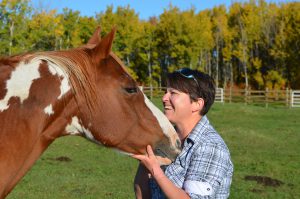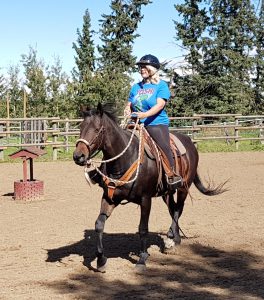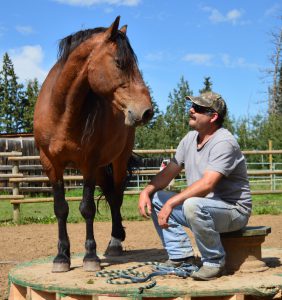I received a great question from one of my students the other day.
It’s a deep one.
Initially I responded by saying, “It will be in my book…when I get to finishing and publishing it!” However the question is a great one and well worth sharing and discussing. Before we get to it, though, we need a bit of a prelude.
Our conversation started off with a reference to Bill Dorrance discussing feel in his book, True Horsemanship Through Feel. The context of our conversation was about feel as an association to connection versus a physical feel for example, through the rein.
As more folks start to migrate to our style of horsemanship and realize what they can achieve, I find myself fielding more questions: “What is feel?” “What is energy?” “What is connection?” These are great questions that, for a large part, require us to discover the answers for ourselves. I can’t tell you how to feel or connect, but I sure can set it up so that you do. That said, I view my job more as a facilitator between folks and their horses: guiding them to discovery. I incorporate realistic exercises and training – my obstacle and trail courses for example – to assist folks in their personal success with their horse and ultimately, the advancement of their horsemanship.
 Without the restrictions of methods and levels, we’re free to explore at our own pace as our abilities grow. That results in our style of training being applicable to all horses and all riders, regardless of breed, discipline or experience.
Without the restrictions of methods and levels, we’re free to explore at our own pace as our abilities grow. That results in our style of training being applicable to all horses and all riders, regardless of breed, discipline or experience.Honestly, once you know a bit about how the horse functions both physically and mentally – and particularly how those two fit together, you’ll be saying, “This is common sense!” As you progress, your horse will start to trust and connect with you on a level many riders are unaware of. But it’s at this level where the world really opens up.
Both horses and humans are relational creatures. Both horses and humans are inhibited by fears. In the protective prey-thinking mind of the horse, anything can be a potential threat to their very existence. It’s critical that we recognize when a horse is unsure or afraid. And when we develop the leadership and communication skills to alleviate that fear and replace it with confidence and trust, the horse will really make themselves available to us.
 Every one of us has the ability to produce freedom in the mind of a horse and develop them to any athletic status – dressage to barrel racing.
Every one of us has the ability to produce freedom in the mind of a horse and develop them to any athletic status – dressage to barrel racing.Lets pick an example. Your horse is having trouble with side-passing to the right and picking up a right lead. This is likely due to a combination of tension and imbalance. We can help him with both. Lets start with some things we know.
We know certain muscles are activated as a response to unease or fear. We call this brace. When our horse is braced, he can’t move athletically. For example, a tight back can result in an inverted posture and an obvious restriction in hind in motion. If you want to feel what brace is like try this exercise:
- Stand up.
- Now, engage (contract) as many muscles as you can.
- Keep those muscles engaged and try to move.
You’ll find movement is impossible unless you release some muscles. That release is what we are asking of the horse.
We know that when the horse releases mental tension, he can release those muscles that prevent him from moving athletically. With his body now available, we can show him how to be balanced – and then those side-passes and right lead departures are there for us.
Humans are not much different. We are great at internalizing. Holding emotions in check. Hiding our fears. We do this for many reasons: we don’t want to try something and fail in front of others. We don’t want to say the wrong thing and upset someone. Even fear of injury – particularly if we’ve been in a wreck with a horse before. Maybe you’re getting back into riding after a long abstinence. There are countless reasons and, just like horses, they’re particular to the individual.
The problem is that when we hold things in, we also hold things back. We’re acting instead of letting our true selves show. I remember taking my first archery lesson years ago with a friend. Of course we wanted to appear masculine and suck that belly in a bit. But the instructor was all over that right away! Why? Because engaging those muscles produces tension. That tension prevents accuracy which is obvious when you look at the target. The answer – release! Relax. Breathe deep. Turn off those muscles that cause tension so that your athletic ability (using the correct muscles in a correct amount at the correct time) is enhanced.
It’s exactly the same for the horse. Still with me? Awesome, because that completes the prelude. So…are you ready to jump into this rabbit hole? Like I said, it’s a deep one!
Here is the great question that spawned this article:
This is a deep question! It touches on many points – each of which could be a book in itself. Lets dissect this question.
People have a plethora of defensive mechanisms that manifest themselves when we work with horses. Do a search on “common defence mechanisms” to read all about it. You’ll relate to some. We all do – we’re only human, after all!
One of the keys to a successful relationship – with horses or people – is to be aware when we engage those defensive mechanisms. Then, choose not to. It’s not easy. The best advice is to practice this in every relational activity – talking and listening to your friends. Reading a Facebook post or text that could tempt you to respond negatively.
Pause. Evaluate. Choose a positive action. By taking that moment to pause and consider your best course of action, you’ll increase your ability to be self aware.
Consistently making positive changes in horses requires you to cause positive changes in yourself.
The advantage of being human is we can choose what we want to feel AND choose our reactions AND choose our resulting actions. Horses can’t – they operate out of instinct. We can change aspects of that instinct, causing them to respond differently to stimulus. However horses are not going to ponder for five minutes on how to react to something – they’ll simply react.
So how does this translate to the horse as far as feel is concerned?
Consider having a conversation with a friend after you’ve had some traumatic experience and need to talk about it. Let’s consider two responses:
- Your friend takes your hand, looks you in the eyes and says, “Tell me about it.” This is said from their heart – with no concern for themselves. To do this requires that they be open to hearing what you have to say – regardless of what it is. It is impossible for you not to feel this honesty and to respond in kind. You’ll likely be moved that someone really cares about you.
- Your friend is thinking, “Oh…here he/she goes again! I DON’T want to hear this!” OR your friend starts reciting some story to top yours OR recounts how he or she handled the same thing. They may even interrupt you to share something about themselves. Again, you’ll be aware when this is happening. And most likely disappointed – this is about YOU after all.
More often than not, people just want to be heard. They don’t need your assessment or comparative analysis– just your acceptance and reassurance. Guess what? It’s the same with horses.
Now I’m going to turn this around and make it real for you. Your horse has something to say to you. They are nervous, unsure or simply don’t understand what is being asked. Which friend are you? #1 or #2? Guess what? You have the power to make that choice.
Here is the difference:
#2 is “It’s all about me!” What the horse requires – freedom from tension and brace, the ability to balance and carry you – isn’t on your radar. Your focus is on your personal immediate goal with your horse versus what the horse needs in order to try for you.
#1 is all about the horse. It’s about lowering your defences and being totally open to listening…to feeling. Without any judgment. Without any preconception. Without any expectation. Because when we go there, we block out ability to feel with our own emotional junk.

If you watch me work with a horse that really needs a reassuring positive connection you’ll likely see me doing a few things to get myself centered: taking a deep breath and letting it out. Relaxing muscles – I unlock my knees as well just to feel loose. I rid myself of any tension I’m carrying. If I go really deep, I’ll close my eyes – our vision can occupy a huge percentage of our brain’s processing power so shutting it off opens your other senses. Now I’m in a place I can feel. With practice this becomes more natural. It’s fairly rare I have to go to that degree of internal peace – starting my wild horse was one of those times.
What is the basis for this? We need to give our horses something to follow. A direction. This is not a physical thing either: it’s no secret that horses can feel what we feel. It’s built into their protective mechanisms. One horse is scared so they’re all scared. You’re nervous so your horse is nervous. They need to have that herd-connected-feel mechanism in order for their species to survive. It’s a finely tuned ability.
We can also develop this ability. And in doing so we develop an incredibly powerful tool: If I feel positive, energetic and ready to take on the world – my horse can mirror that feel too! Wow.
Connection and Feel are simply energy moving between you and the horse. When I teach clinics we chat about the methods that horses use to communicate. We learn and demonstrate that horses primarily communicate through their space and energy. Those that work their horses at true liberty – where the horse is moving in response to the directed energy of the handler – will understand this. We’ve all seen it and many of us have done it. It’s enlightening…addictive! I love to show folks how liberty exercises directly enhance their riding.
Connection and Feel are analogous to a fire hose. The hose connects you and the horse. When nothing is going on, it’s flat. When it’s in use, water can move through it in one of two directions. The pressure of the water can be increased or decreased. But if we clamp that hose in the middle, it won’t work at all no matter how much pressure we put out there. This is common: many of us have a huge reservation about showing our true selves. Letting go of our defenses and allowing ourselves to be unguarded, exposed. Being open to trying…and screwing it up. To laugh at ourselves.
When we give power to those reservations, we put a clamp on that hose. I’ve had people tell me, “I’m trying to be energetic and my horse is not responding!” Remember potential and kinetic energy from grade school? We can build up a ton of energy within us (potential) but if we don’t let it out (kinetic) then nothing is going to happen. We’re literally putting the pedal to the floor of our truck – while it’s in park. That energy isn’t getting out there. If you’ve closed the door to letting anything in (i.e. being exposed and unguarded) you’ve closed the door to letting your energy out as well.
To wrap this up, we can choose to be open…unguarded. We can also choose to be self-serving and defensive. The latter doesn’t work so well with horses; we’ve shut off the lines of communication. Those that ride or train in this defensive regime are the ones that resort to control, submission and obedience to make their horse do what they want. This is never successful in the long run.
On the other hand, those that are open to and willing to learn how to to communicate with the horse in their native language of space, energy, empathy, motivation and focus will feel like the light has just been turned on. Their horses will move with fluidity; free from mental and physical tension.
These are the horses that are willing to try anything for you.
These are the horses that have a look of pride, contentment and achievement on their face at the end of a training session, whether they’re sweating or not.
These are the horses that will look you in the eye like they’re staring into your soul and thinking, “I trust you. I like to be with you.”
These are the horses that stay glued to your side when you take the halter off and walk away.
These are the horses that you’re going to tell stories about for the rest of your life because the experiences were so fantastic and in many cases, positively life-changing.
Scott Phillips
April 2017
